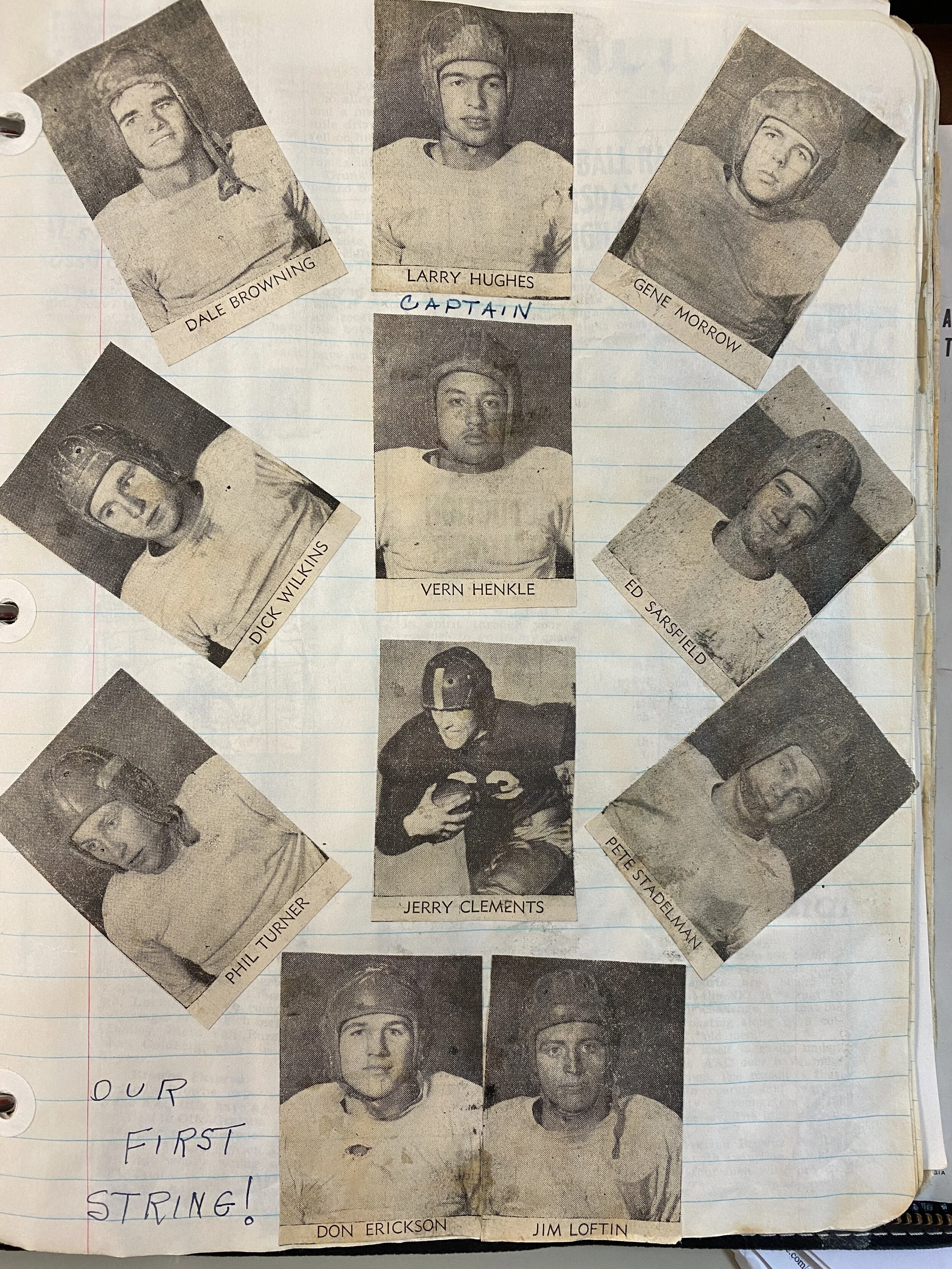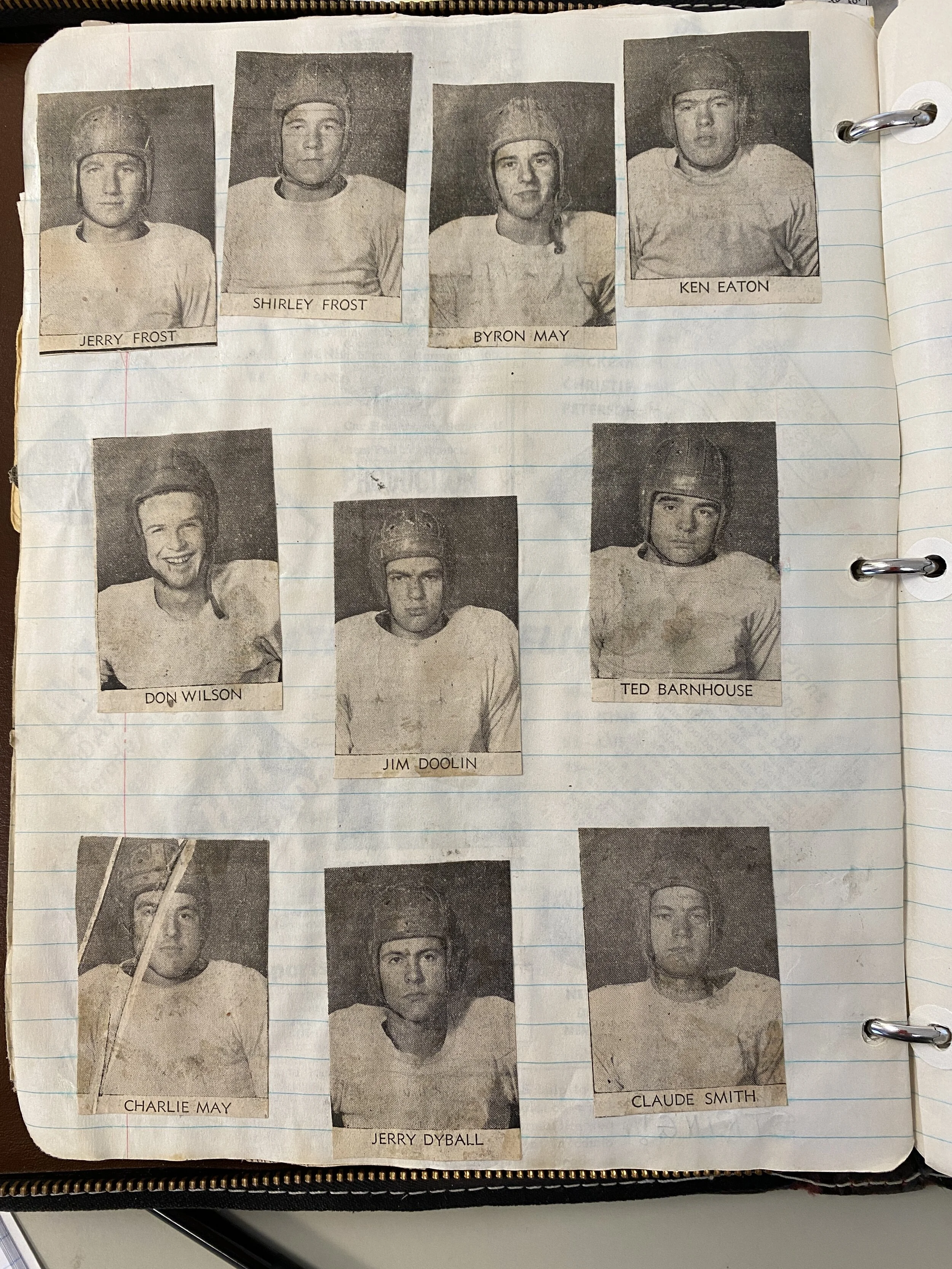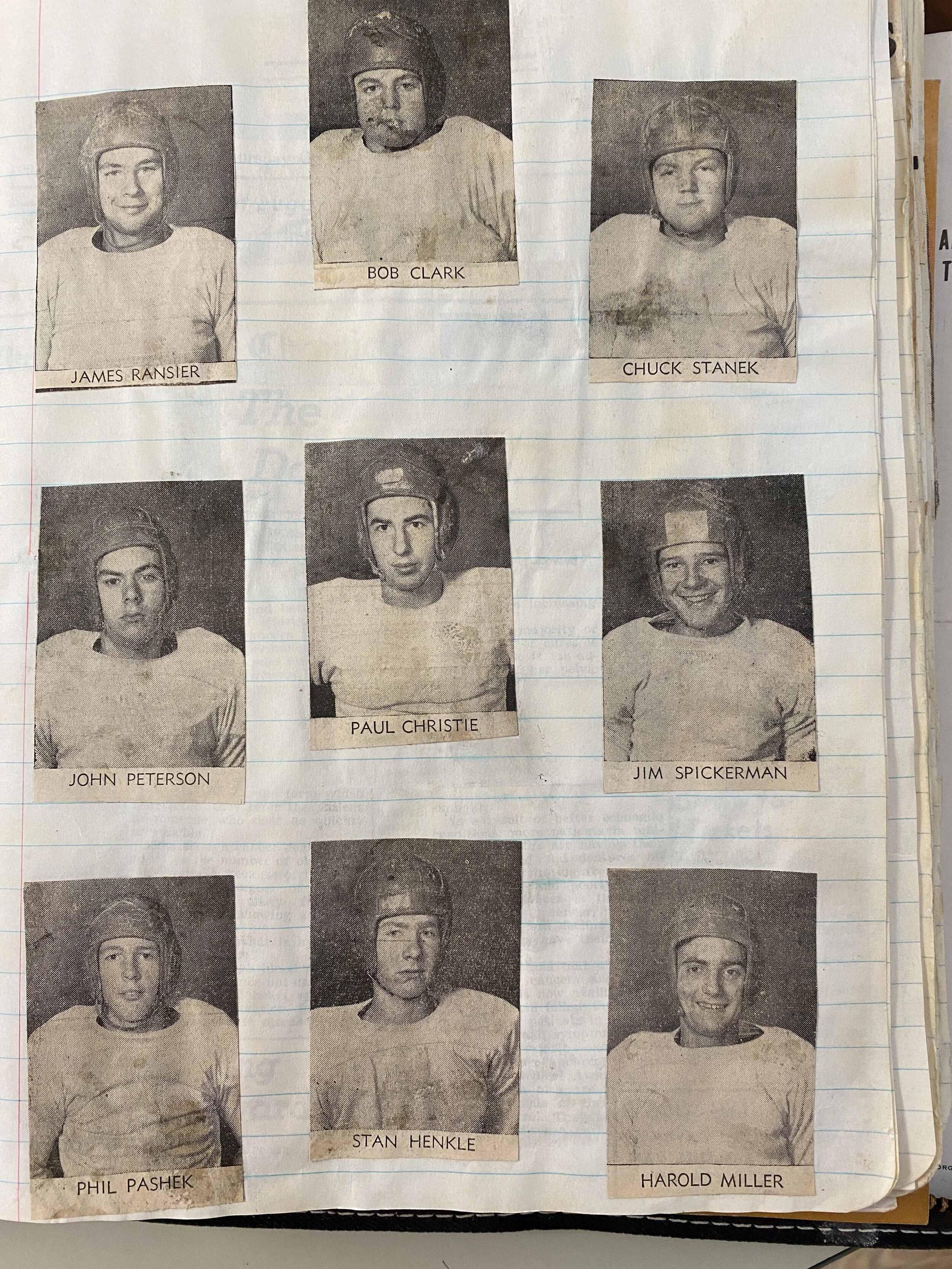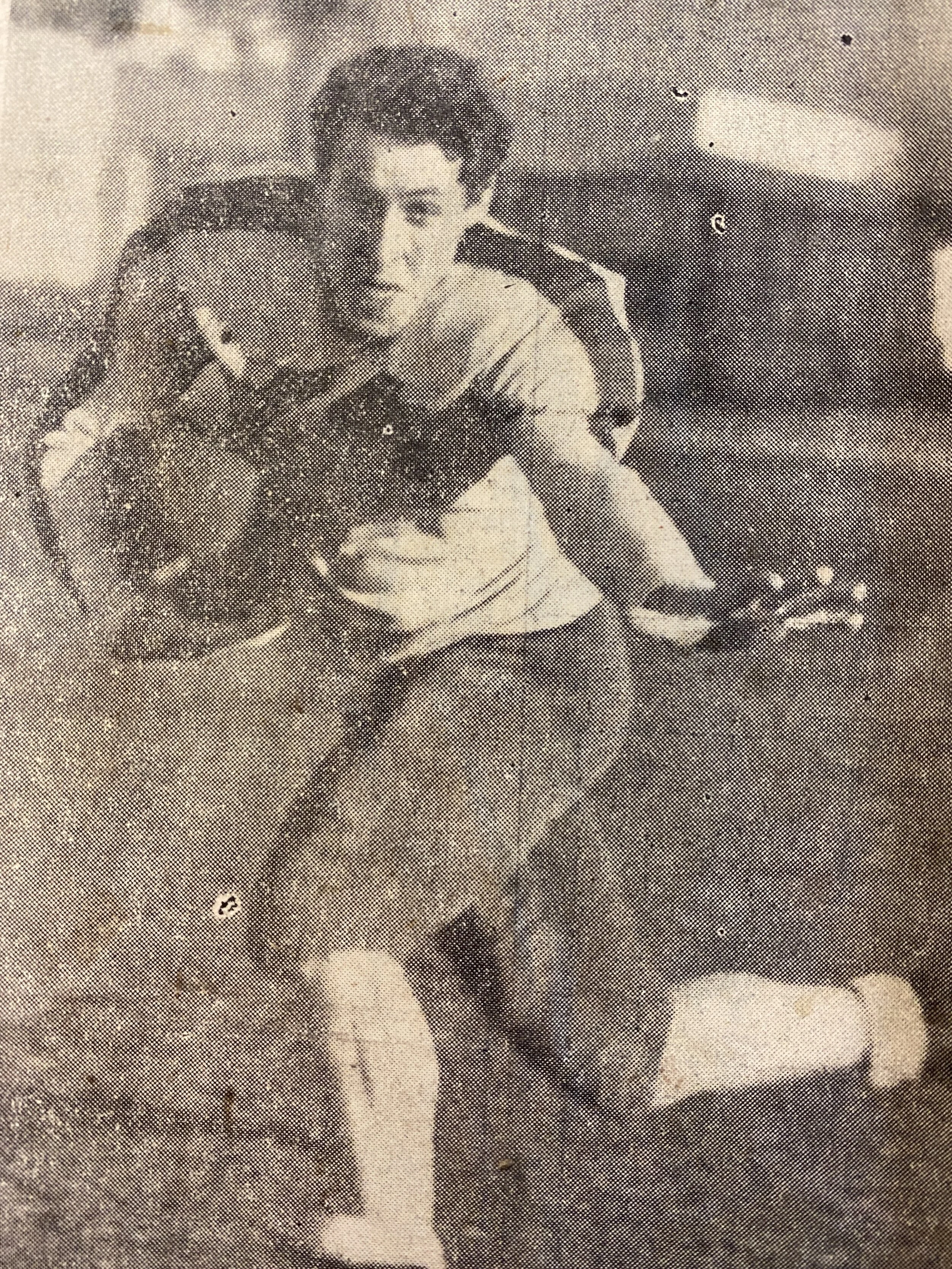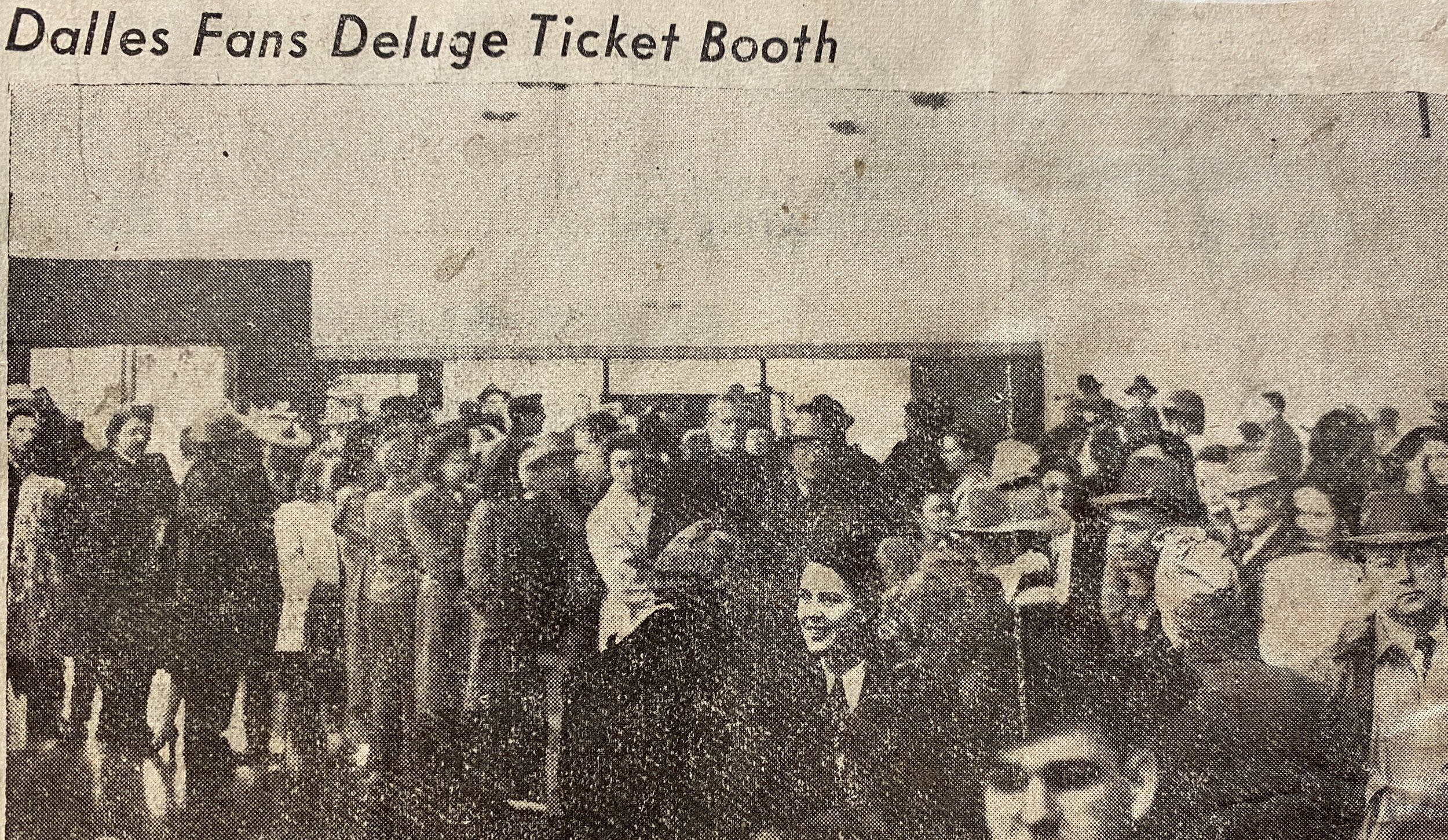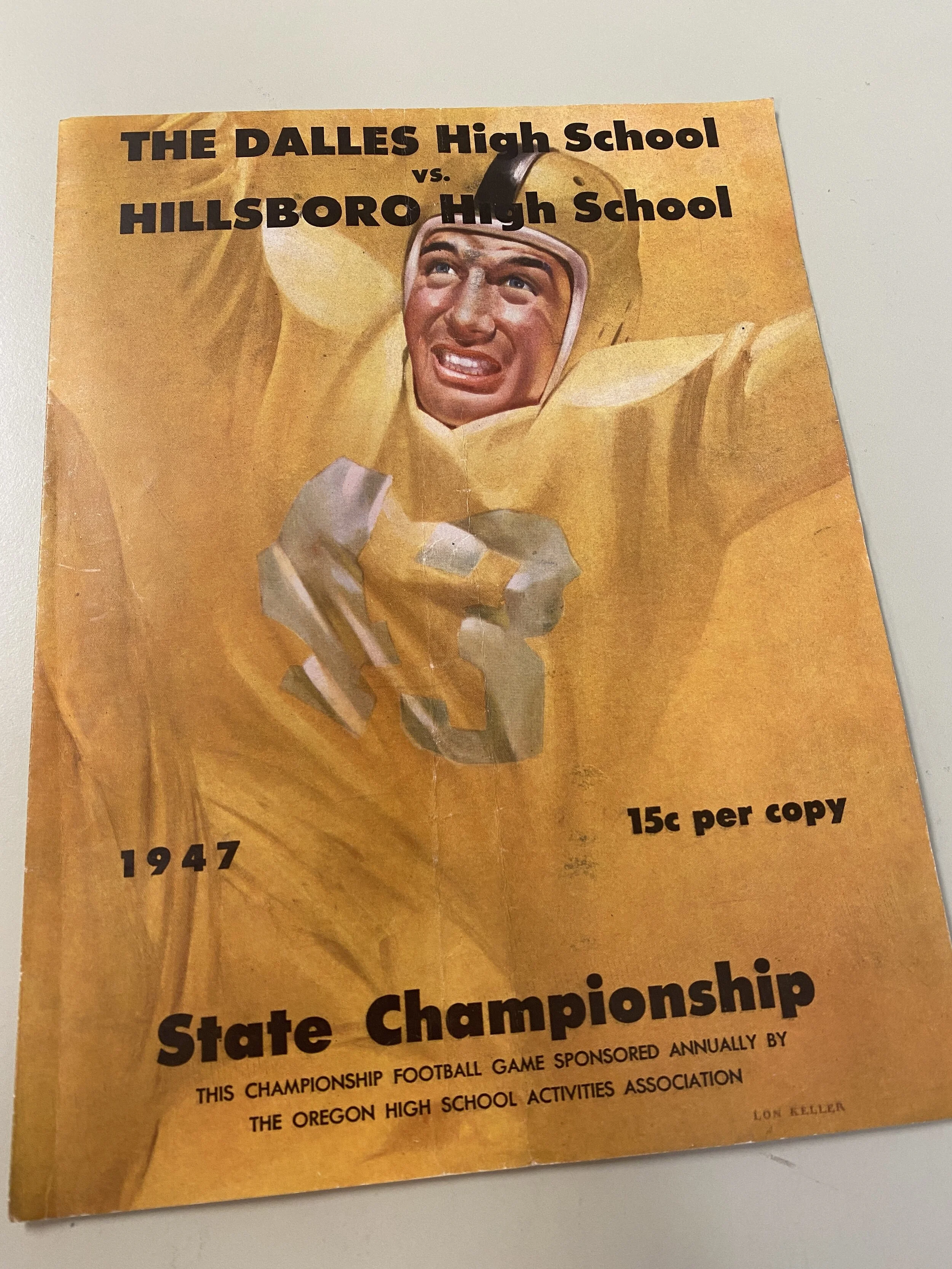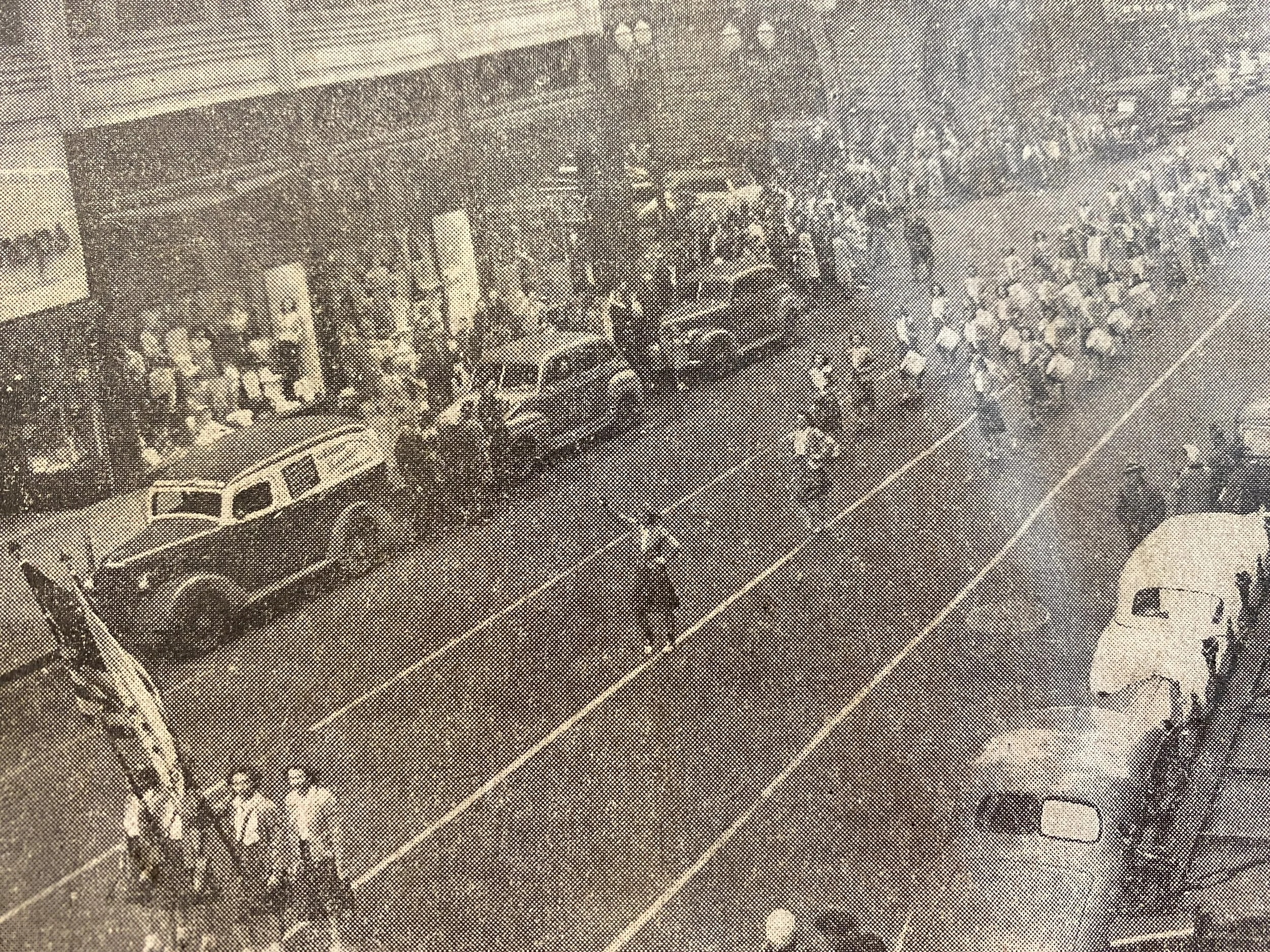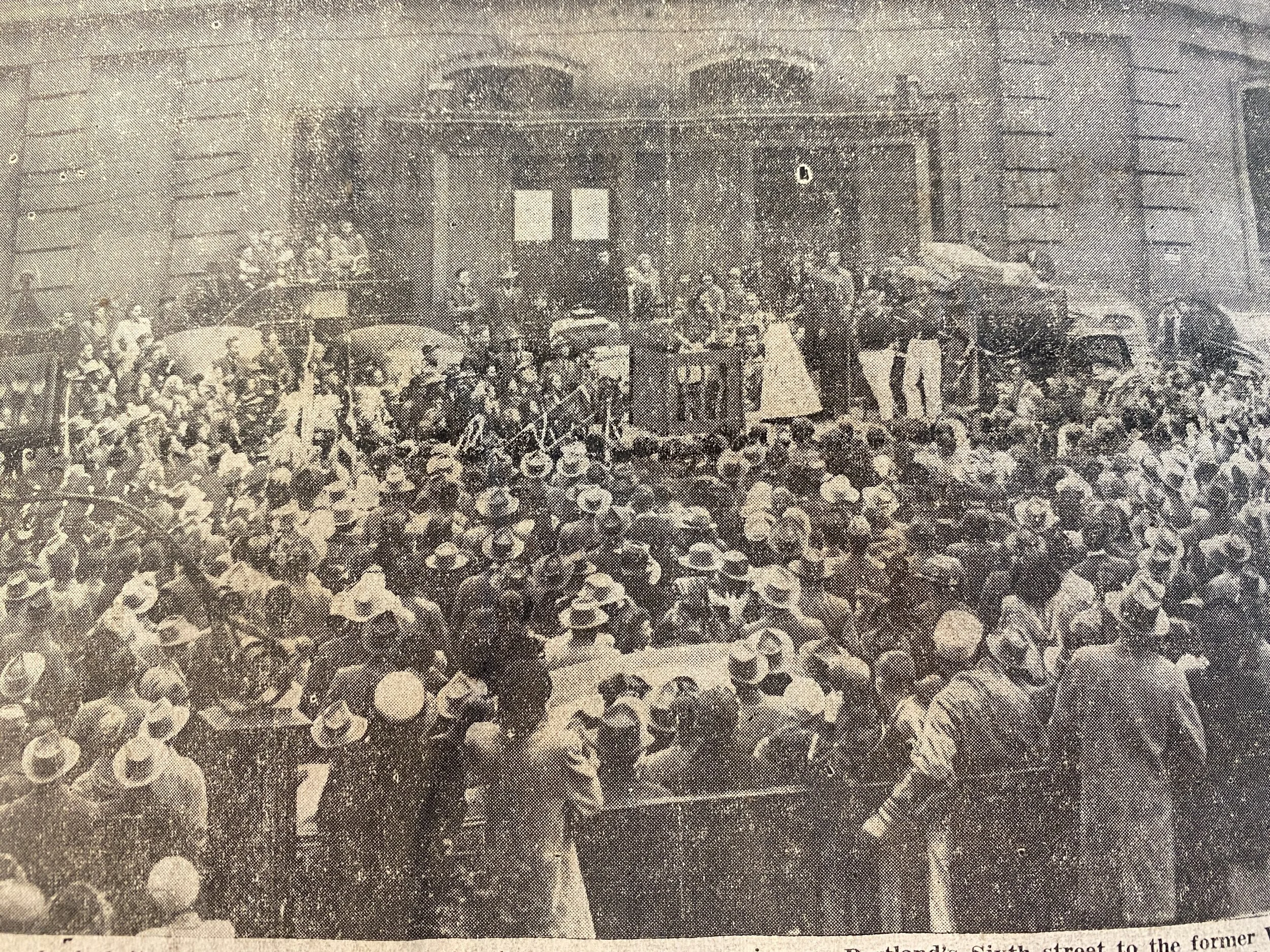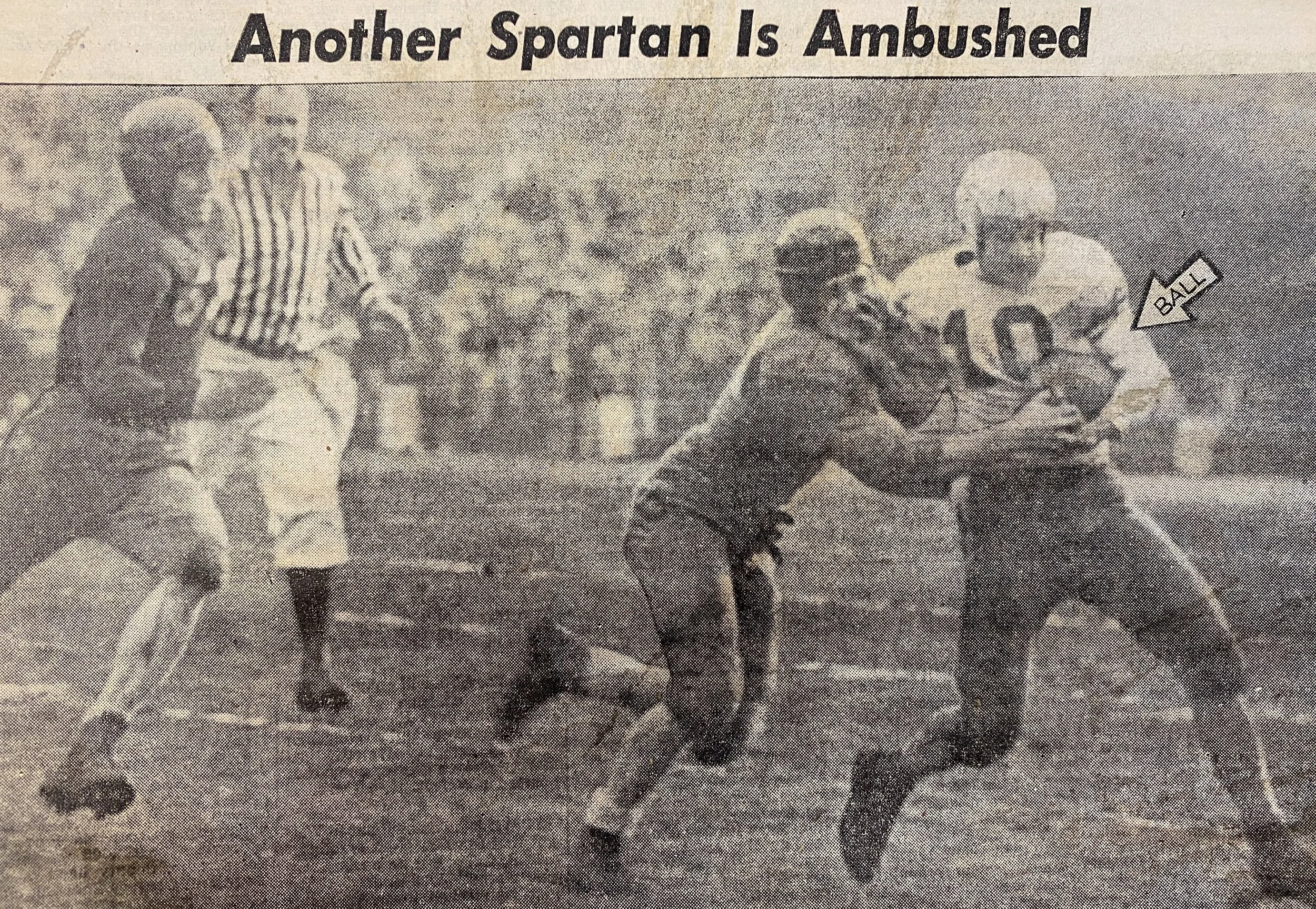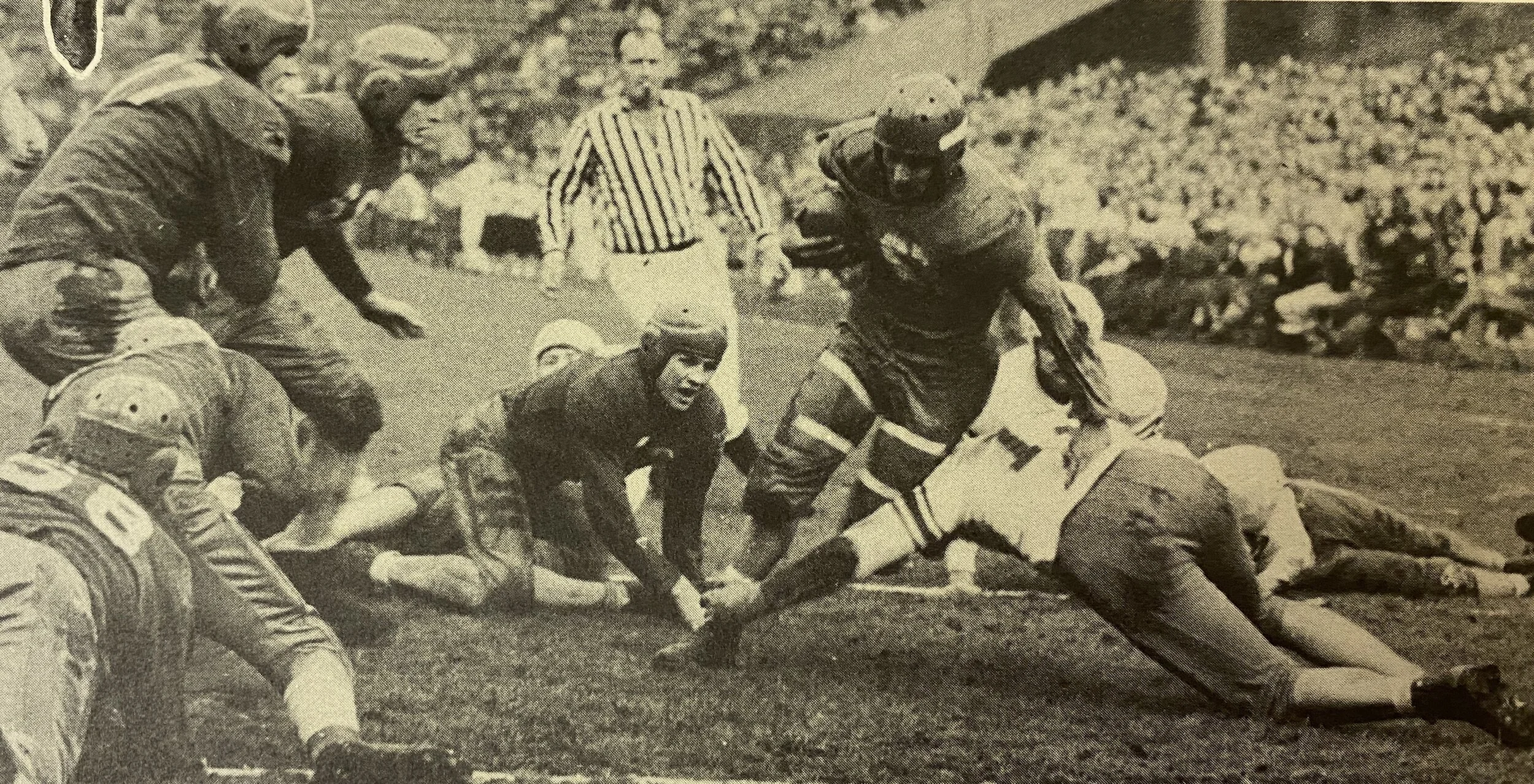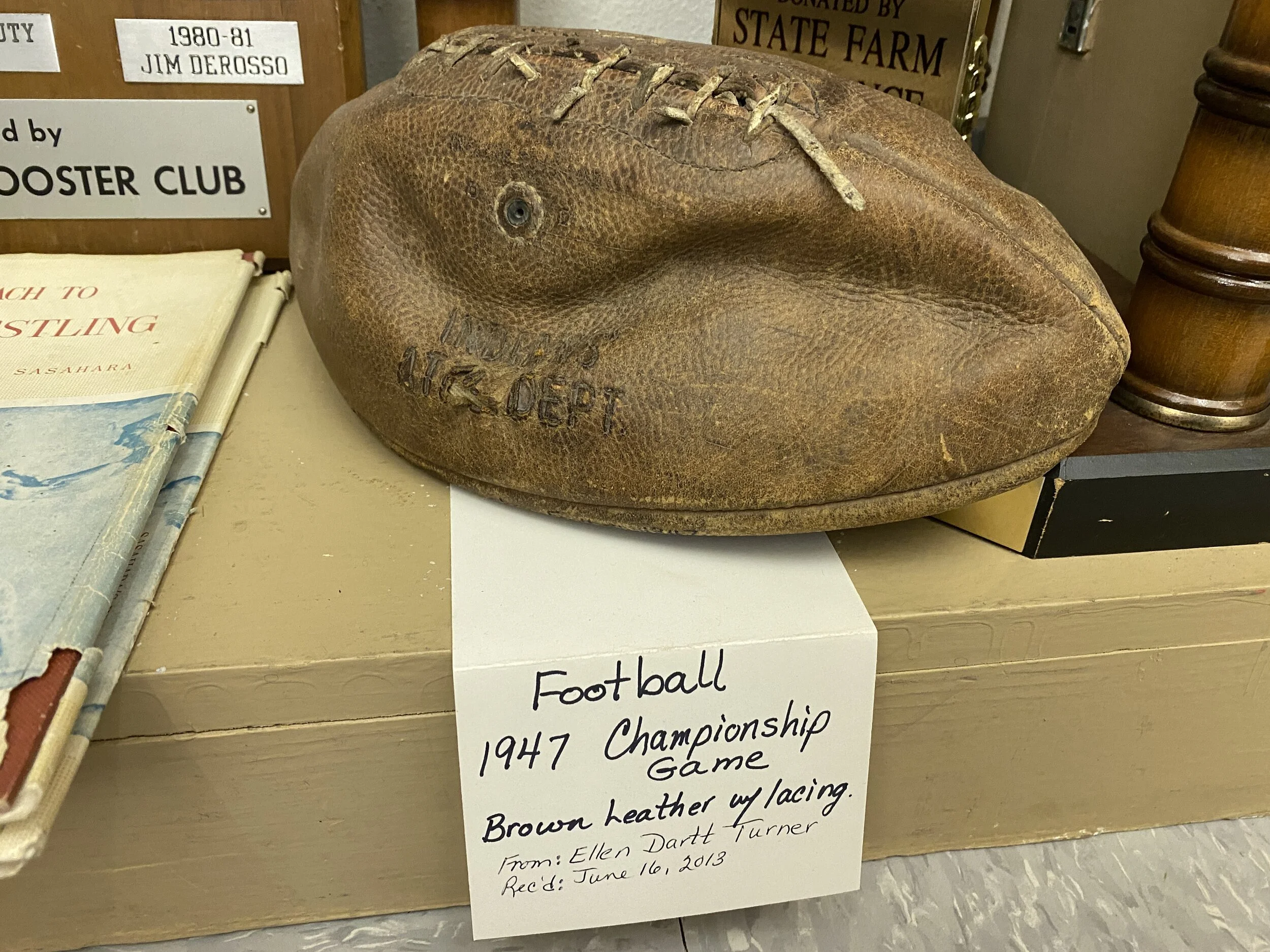TD Football 1947 - Tackle for The Miracle
Captain of the Football Team - Larry Hughes of The Dalles still fits neatly into his letterman sweater. Hughes was the captain and right guard of The Dalles High School Football team in 1947 when the team took the state championship. Thousands attended games at Amotan Field and the community, including service groups and business leaders, put huge support behind the high school.
By Tom Peterson
You may know The Dalles captured the Oregon State Football Championship in 1947.
And you may know about the team absolutely knocking the helmets off the Hillsboro Spartans in a 47-7 blowout in front of 14,000 fans in Portland to grab the title.
Dale Browning in 1947. He played quarterback, providing blocks not passes.
But, that’s only part of the story.
The longest half hour in the history of football in The Dalles took place on Nov. 21, 1947, on Amotan Field when TD crashed with Klamath Falls and fought to a tie on the scoreboard.
Larry Hughes was the team captain and right guard of that team. And Dale Browning was the blocking quarterback. Neither has let the memory fade.
The men, now both in their 90s, reflect on that year with pride. There are only four other members of that team that are still around - Claude Smith, Chuck Stanek, Stan Henkle, and Jimmy Spickerman.
Hughes and Browning look back in amazement at how The Dalles, when pulling together, was able to accomplish almost anything.
It was “life-changing,” they said.
Both men went on to their own successes.
Hughes later owned and operated Hughes Feed & Grain in The Dalles. Browning became a medical doctor in Portland and was the team doctor for David Douglas High School. He also practiced sports medicine for Portland State and Mount Hood Community College. He married his high school sweetheart Nevelle (Bode) Browning, a Booster Club Girl.
The men track their winning spirit back to that pivotal year - 1947.
Here is the rest of their story
Early in the Season - A Photo of the 1947 The Dalles High School Football team.
Full disclosure - my uncle, John Peterson, was on this team. He stepped into an irrigation ditch during practice early in the season and injured his knee. He walked with a cane in his later years due to the misstep. In addition, I came to know Charlie May, Vern Henkle, and Phil Pashek in later years. Phil’s better half, Barbara Pashek, and Charlie’s better half, Loye Ann were both true pistols - I always looked to them for strength and a good laugh. They always have both - Tom Peterson
1947 was turning out to be a pretty good year for The Dalles High School football team.
Despite a dismal 3-5, season in the previous year, the community of The Dalles was coalescing around a group of young men that were showing potential.
A fever took hold as the squad returned 12 lettermen and nine first-string players.
And the school packed its arsenal with two outstanding transfers in Ed “Tiny” Sarsfield at 6’ 6” and 250 pounds from Goldendale and Dick Wilkins of Condon, a 147- pound speed demon liable to break for 20 yards on any given run.
During that season of ‘47, residents of The Dalles showed up by the thousands for football games packing bleachers and encircling the field, rooting, chanting and shouting. The Dalles Booster Girls were 47 strong at halftime shows with bugles, drums and majorettes.
Nevelle Browning played the bass drum.
“I kept them all in step,” she said. “It was really an all-town thing. Everybody got really up for it.”
Huge support from downtown merchants and businesses all kicked in to finance the endeavor.
The Dalles High School Band joined with the Whittier Junior High Band to provide spirit at the football games.
“We were not denied anything,” said Beverly VanNice, a flag bearer for the Booster Girls, noting the season included pep rallies, train rides, and the feel of the community pulling together to push the program to greatness. The High School was state of the art, just seven years old from when it burned in 1940.
The Dalles Dam did not exist. There was no Interstate-84, just Sam Hill’s winding historic Highway 30 that took hours to negotiate on the way to Portland.
And yet it seemed anything was possible. It seemed a state football title was within reach.
The Dalles team, under coach Dick Sutherland, a young, good-looking guy out of Oregon State University gridiron, would soon turn his players into a high-flying air raid with a tough running game and a brutal defensive line.
Phil Turner, of Turner Furniture, now Maupin Stoves and Spas, was the fastest on the team at left halfback.
He was a mere 145 pounds. But nobody could touch him in the open field.
Toppenish at Home
In its season opener, The Dalles played the Top-Hi Wildcats. Senior Gene Morrow playing at fullback called audibles and threw and ran the ball with the aid of Turner and Wilkins in at left halfback and right halfback respectively. Both were deadly fast and a tough matchup for the best of defensive teams.
The Toppenish, Wash. team could not touch them. The Dalles more than doubled their opponent’s yardage.
The Dalles won decisively, 27-0.
Morrow, an eventual starting quarterback for Oregon State University, threw bullets.
And they rolled.
The Dalles downed Bend 32 to 21; Central Catholic, 48 to 0; Hermiston, 60 to 7; Pendleton, 12 to 0. During the season, upstart Charlie May, a 14-year-old freshman, made his way onto the team, making a sizable impact in both defense and offense and adding to the scoreboard. He could crack the line and score.
The team also had a secret weapon in Bob Murray, a former TD coaching legend who scouted opponents.
Murray warned the team about Emile Holeman with the Pendleton Buckaroos. “He said Holeman at fullback was a tank and we would have to stop him to win,” Hughes said.
Hughes tackled Holeman head-on during the game as hard as he could, and they both went down.
Hughes was knocked out but regained consciousness. He continued to play the game. He said left guard Vern Henkle had to tell him what to do before every play.
“It worked out ok because I had an interception and I recovered a fumble,” Hughe said.
Holeman went on to play football for the University of Oregon and was a Umatilla County Commissioner. He later moved to The Dalles, living in Hughes's first home. Holeman recently passed on June 7, 2020, while living at McKay Creek Estates in Pendleton.
There were several games, where first-string players earned the “ironman,” being on the field the entire 48 minutes playing both offense and defense.
Hughes said The Dalles, which became a famous second-half team that year, was better conditioned and could put the hurt on when other teams were fading.
He said training and mentoring were key.
After beating the Pendleton Buckaroos on Oct. 10, everyone in The Dalles was convinced they had a contender. And why not. They had outscored their opponents 179 to 28, thus far in the season and 1567 to 582 yards.
The Dalles continued to reel off wins.
They slogged it out at Oregon City, playing on a rain-drenched field in four inches of water. The smell of stock animals emanated from the field. It was located at the Clackamas County Fairgrounds.
“It was the most miserable game I played,” said Browning.
They won 19-0, but the Greyhound bus that transported the team would not start after the game. The team spent an hour in their soaking wet uniforms while the bus was worked on.
“We had to push the bus to get it started,” Browning said. They then drove to the Oregon City High School to get cleaned up, while the bus driver kept the engine running. The water heaters in the school malfunctioned, and they had to take cold showers.
The team ended up at Sandy - again, this is before Interstate-84 - and they ate at a new drive-in. In Hughes's scrapbook, it states the team got home at 4 a.m. Hughes kept a screw from the bus.
The Dalles Vs. Klamath Falls, Round 1
The team's next test came against Klamath Falls at home on Oct. 24. The big Pelicans had drubbed The Dalles 60 to 26 in the previous year. Hughes said it was payback time.
The game was preceded by a Thursday rally including 1,400 screaming fans and the University of Oregon tumbling team pulling tricks for the crowd at Kurtz Gym.
Hughes was quoted in the newspaper saying they were “fighting mad” and looked forward to avenging their loss. The rally also included flying Pelican feathers.
Student Body President and football player Shirley D. Frost led the festivities. Frost would later become a Rear Admiral in the Navy and then take the highest non-appointed post in the Federal Reserve. He died just last July.
Several pages out of Larry Hughes’s scrapbook shows the entire team.
The Pelicans were on average 16 pounds heavier and had some standouts in the backfield. But scouts had found a tell on the Pelicans’ 206-pound fullback phenom Leonard Heston.
Browning said Heston always lined up with his right foot back when he was going to carry the ball.
“We keyed in on that the whole game,” he said. “When it got called, we all pinched to the middle to close it up. That’s how we contained the fullback.”
It was a brutal game with tempers at fever-pitch during the struggle.
The Dalles beat the Pelicans in a matchup that had sports reporters charging unnecessary roughness in newspapers in both communities. In the game, The Dalles went to the air to down their opponents 26 to 12. Four long passes by Morrow were the difference in the battle. The contest was much closer on paper, with the Klamath team earning 14 first downs to The Dalles’ nine. The Dalles edged them in total yardage 294 to 262.
Fleet-footed Phil Turner, had an incredible season in 1947. He later went on to own and operate a furniture store in downtown The Dalles.
In the Klamath Falls Herald, it was reported that the “Pelicans had to take rough riding from the grandstand jockeys up at The Dalles Friday night… Rougher elements among the paid customers were doing all the hooting and even roughed up Lester Foster (Pelican Lineman) and Jim Crimson, cheerleader, after the game.”
The Dalles Optimist newspaper quickly responded in an editorial entitled, “A Klamath Joke”.
It stated, “As we view them, the bust-’em, twist-’em tactics by a few of the burlier Pels reflect upon the type of training these youths are receiving on the practice field.”
Oregon Governor Earl Snell and his wife Edith (Welshons) Snell were in attendance at the Klamath Game at Amotan Field. Dick Wilkins was Edith’s nephew, and the right halfback did not disappoint in that game with 48 minutes of play and several brilliant runs. He intercepted a pass and ran it back to the Pelican’s 5-yard line in the first quarter.
It was the Governor’s last game. Snell, who hailed from Arlington, died four days later in a plane crash in Lake County while on a goose hunting trip.
No doubt, the Klamath game was an ominous beginning in a rivalry that would end in what Browning called the biggest memory in his collection from that year.
The Dalles reeled off two more wins to finish their regular season - defeating La Grande 26-6 and then the Hood River Dragons 51-0 in a final and crushing blow.
Hughes said the victory was especially sweet as some Dragons turned firebug and covertly came into The Dalles several days before their pre-game rally. They lit off The Dalles giant “D” on an east hill in town. The fire was intended for a rally before the big game which was played on Armistice Day. The Dalles High School was let out early so students could refill the D with more tires and the rally and bonfire were held.
Hughes said he may have used gasoline to kill the grass in the shape of a D out front of Hood River High School shortly thereafter.
In the meantime, Klamath Falls continued to win out in its league, beating Bend in its final game of the season, 13-12.
The Quarter-Final, K-Falls Vs. The Dalles, Round 2
The die was cast.
The Dalles was reset with the Klamath team on Nov. 21. The winner would advance to the semi-finals of the state playoffs. Klamath Falls pushed for a neutral field but were denied, and the game was to play at Amotan.
Ticket sales were brisk for the much anticipated rematch with Klamath Falls.
News of the matchup sent The Dalles into a tizzy for tickets, with people waiting in the rain for hours to get a front-row view. Tickets went for $1.25 and $1.
The Dalles Mayor Howard Dent Jr. proclaimed the day of the game a holiday. Even Hood River High Students were let out early to cheer The Dalles on that Friday.
They were not disappointed.
It was a different game entirely from the regular season. Klamath Falls had done their homework.
And heavy rains during the week favored the heavier Pelicans with a strong ground game.
“The passing game was destroyed because of a lot of rainfall that week, and we had mud puddles standing in the field,” said Hughes. “Janitors had used sand to fill them up, but we played with just one football, and it got covered with sand,” he said. “We had trouble handling the ball.”
Neither team had success in the first quarter. And late in the second, The Dalles Wilkins intercepted a Klamath pass near The Dalles goal line and ran it back the 38-yard line, seemingly taking Klamath out of scoring position.
But on the next play, Morrow’s pass backfired. Pelican halfback Jerry Shubert intercepted the heave and ran it back 45 yards to score standing up. Klamath’s kick for the extra point went wide.
Halfway through the melee, the score stood at 6-0, Klamath Falls.
At the beginning of the third quarter, Klamath caught another break when Wilkins kicked a short punt, and the Pelicans began their offensive assault on The Dalles’ 19-yard line.
The Pelican’s Leonard Heston hit the middle for two yards and then Klamath’s flashy scatback, Tommy Edwards, circled wide around right for 17 yards and another Pelican score.
Klamath passed for the extra point, and the score now stood at 13-0.
For the next several minutes, the teams were in a defensive standoff as precious seconds ticked off the clock.
Time was running out on The Dalles.
“As I remember it, there were five minutes to go in the game, and we were behind by 13 points,” said Browning.
“I called a time out,” Hughes said. “And we decided to invest in the two-minute drill. We called three plays ahead of time in the huddle and rushed up to the line of scrimmage…”
Instead of long passes, Morrow started throwing short and hitting his receivers.
Morrow started with a 14-yard pass to lanky Don Erickson, moving The Dalles to the Klamath 21-yard line.
Turner drove the ball for five yards. And then Morrow pitched a strike to a diving Wilkins who caught the ball just two feet from the goal line for a first down.
In this photo, the arrow points to Dick Wilkins catching the ball and falling two feet before the goal line. The crucial play added a much-needed first down to The Dalles stats.
Morrow hit center for the touchdown and then passed to Turner in the endzone for the extra point.
The score stood at 13-7, and all of a sudden it was a 6-point game.
After the ensuing kickoff, The Dalles held the Pelicans to a three-and-out, forcing a punt.
They got the ball back with just two minutes on the clock.
Turner took the punt and ran it back to their own 25-yard line where he slipped and fell.
It was do or die time.
“Larry Hughes team captain came to the huddle and says, ‘let’s run the ball’ and it just ignited the whole team,” said Browning.
“We had learned the Idaho Spread because that was what Hood River ran, and it was an entirely different philosophy,” Browning said. “Coach Sutherland knew we needed a touchdown and there was very little time left. He called Gene (Morrow) out to the sideline and called the Idaho Spread - it was not even in our playbook. They lined Turner at my position and put me out as a wide receiver and we spread from sideline to sideline and the linemen took huge big splits 10 feet apart, and the Klamath Falls Coach was sure we were going to throw deep.”
“What it was is a little screen pass to Turner,” Browning said.
After the snap, Morrow lobbed the three-yard pass to Turner who went in behind the offensive line. Turner, weaving in and out of five Pelican would-be tacklers, picked up his blocking receivers downfield and then outran them all until a Pelican hit him at the 10-yard line. Turner was traveling so fast he spun and went over the goal line for 78 yards and the score.
The crowd went wild.
It was knotted at 13.
Morrow’s pass for the extra point and win was blocked by the tough Pelican defense.
The clock expired with 13-13 on the board.
“The Dalles line played their best game of the year,” according to The Dalles Chronicle. “Time and again they broke through the heavier barrier to toss Pel backs for losses. Jim Lofton, playing with taped ribs, stood out on defense, and although injured twice, was in there at the finish.”
“In the backfield, Morrow, Turner, Charlie May and Dale Browning held the limelight. To Turner and Wilkins go the nod for streaking end runs while Morrow held the passing spotlight and Browning and May turned in beautiful blocking assignments.”
The Longest Half Hour
At 13 all, the game was to be decided on stats.
Gene Morrow played fullback but essentially held the duties of a modern day quarterback for The Dalles team in 1947. He went on to become the starting quarterback for Oregon State University.
Hughes was in the locker room at Amotan Field, sweating out the longest 30 minutes of his life.
He and Browning had blocked and tackled and run into the midst of an undefeated season and were just two games from the State Championship in Portland.
Seconds, then minutes dragged by as the sweat of their brows continued to run in the minutes after the bout. Morrow likely paced, his hand tired from gripping the sandy pigskin on a rain-drenched field.
The other legends of our community, Vern Henkle, Phil Pashek, May, Pete Stadelman, Chuck Stanek, Jerry Clements, Jim Loftin, Don Erickson, Don Wilson, Harold Miller, Byron May, Ken Eaton, Claude Smith, Jerry and Shirley Frost, Jim Ransier, Jerry Dyball and Jim Doolin all waited, having cemented a work ethic and chemistry that had devastated most every opponent they had met thus far on the gridiron.
And now, everything or nothing rested on this decision.
A crowd of some 4,000 packed the field and bleachers, pitching and yawing over the fate of the season.
What was taking officials so long?
The community collectively took a deep breath.
The Klamath Falls Pelicans were in the visiting locker room, equally fatigued, the weight of the decision bearing down.
In the event of a tie, the game was decided on first downs.
Again, the teams were tied at 8 first downs each.
And so it came down to yardage. The totals would decide who went home and who went to the semi-finals.
Statisticians Joe Peak of Klamath Falls and George Sampson of The Dalles were digging into their play-by-play figures.
“The whole season was pivoting on that tally,” said Hughes.
Something magical was unfolding.
The Dalles had run up 281 yards to the Pelican 183.
The Dalles had won, and the locker room erupted.
“We were wrapped up in a lot of emotion,” Hughes said. “Tears were coming out and people were joking and others were crying. We knew we had done our best when we tied the game up.”
“It was a tackle for a miracle,” Hughes said. If Wilkins had not been taken down 2-feet before the goal line, The Dalles would have lost on downs.
On to Albany
The Dalles Band marched to the station to catch this special train to Albany for the state semi-final football game.
The Dalles went on to play Albany the day after Thanksgiving in front of a crowd of 6,500.
Seven The Dalles businessmen - Wilbur Stadelman, Lile Hoover, Pat Foley, Fred Mauser, Carl Stiefel, Ray Kelly and Lay Carlisle contributed a total of $375 to pay for an eight-car train to take The Dalles Booster Club and band and some 250 fans to Albany.
Jim Lofton of The Dalles gets a congratulatory hug after the Albany semi-final.
Once in Albany, they marched through the streets from the station and into downtown with an escort from Albany Police. Startled Albany residents rushed outside of businesses and leaned from windows to witness the ruckus, according to news reports.
On That Friday night on a fog-covered Hudson Field, the team fell behind 12 to 0 against the Bulldogs, but then crushed their opponent in the second half, holding them to 11 yards on the ground and not a single first down.
They won the game easily 19-12 as Stadelman ran in a fumble, Charlie May punched in on a sneak and Turner finished it with a final run on the left end crossing the goal line standing up.
“This town was really behind us in those days,” said Mareta Maier who played bugle with the Booster Club. “It was the highlight of my life. We were treated like royalty by the people of The Dalles.”
The team received multiple telegrams from service clubs in The Dalles urging them on to defeat the Albany Bulldogs.
After the game, Coach Dick Sutherland took The Dalles team to Multnomah Stadium - the current location of PGE Park - in Portland, the site where they would play the Hillsboro Spartans in 7 days for the state title. He wanted the team to get acquainted with the stadium, which could hold up to 30,000.
State Championship - outweighed, outclassed and crushed
This is the actual program from the Championship Game in 1947.
The Dalles Booster Girls and the high school and junior high bands led some 2,000 locals on a parade down Sixth Street in Portland on a march to Victory Center in Pioneer Square before the Championship game.
Residents of The Dalles rallied in Pioneer Square while their team prepared at Multnomah Stadium several blocks away. The Stadium would later become PGE Park.
The Big Game
Larry Hughes scored the first touchdown in the melee against Hillsboro during the championship game.
The Dalles was set to play Hillsboro after the Portland suburb upset Jefferson in their semi-final. Hillsboro was the alma mater of TD Coach Dick Sutherland. The game was set for Saturday, Dec. 6 at 1:30 p.m.
Under requests from the community, The Union Pacific brought in a special 13-car passenger train to transport local fans, both the high school and junior high bands and the Booster Club to and from the game.
The round-trip fare was $3.85, and thousands took the UP up on the deal, including many from Hood River.
The 1947 State Football Championship trophy, which is still proudly displayed at The Dalles High School.
On game day, some 2,000 Dalles fans arrived at Union Station in Portland. They gathered at the train station and then marched up Sixth Street to Victory Center in Pioneer Square and held a rally.
Meanwhile, The Dalles team was preparing to devastate their opponents.
Before the game, Sutherland told the team he had a dream that the Hillsboro quarterback Randy Harrison faded to the left and the threw to a receiver on his right and Hillsboro scored a touchdown to win the game.
In the first Quarter, Hughes saw that very play. He was able to step in front of the pass and intercept the ball. He took the pass from Hilhi Spartan Jerry Doyle and Hughes ran tit back 89 yards for a touchdown.
Turner scored the next 6 points on a running play.
Charlie May, at just 14-years-old, cracked the left tackle for 6. And Morrow crashed through for 6 more, leaving the score 26-0 at the half.
The slaughter continued in the second half. TD’s Wilkins scored on a 22-yard reverse from Turner and the extra point was good for another 7.
Championship Game at Miutlnomah Stadium
The Dalles end Don Wilson executed a perfect end-around for 6 and the extra point took the score to 40-0.
The Spartans got their lone score in the last 5 minutes of the game. But The Dalles quickly returned the favor with Morrow connecting with Wilson on a short pass to the endzone. And Jerry Clements’ extra-point kick finished the scoring at 47-7.
The Dalles had put up 346 total yards to Hillsboro’s 220.
The Championship Game ball is at The Dalles School District Museum.
Fitting End
It was a fitting end to an undefeated season. One in which sports reporters were comparing The Dalles team to dynasties that had come before them.
“The whole community got behind that team and there were lines of 5 or 6 deep all the way around the field and all the stands,” Browning said. “When we were in contention - we used to get close to 5000 people to our games in The Dalles.”
Hughes said in the years after that championship locals would continue to congratulate him and remember that season when seeing him at work and on the streets. He said there is a tremendous amount of pride in The Dalles community.
“That kind of support I have never forgotten,” he said. “I am immensely proud of working with those people. A lot of inspiration came from that team.”
You can watch the entire 1947 Championship Game by clicking below on this Youtube video. Hughes’s grandson, Tyler, recently put the video on the site. The play-by-play was done by KODL’s Al Wynn and Cliff Zonner with the help of Dick Wilkins some 20 years after the game. It was dubbed over the silent film.
This story was sponsored by Brown Roofing, preserving history one roof at a time.
Want to see more content like this at CCC News?
Take our poll to tell us what kind of content you’d like to see more of.








